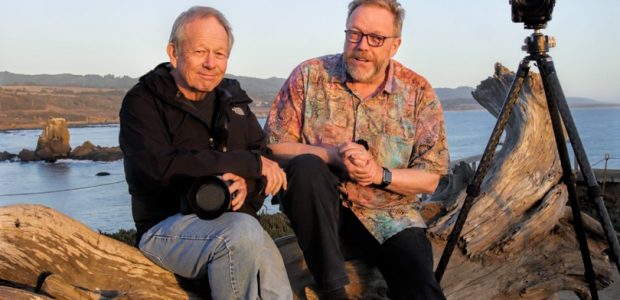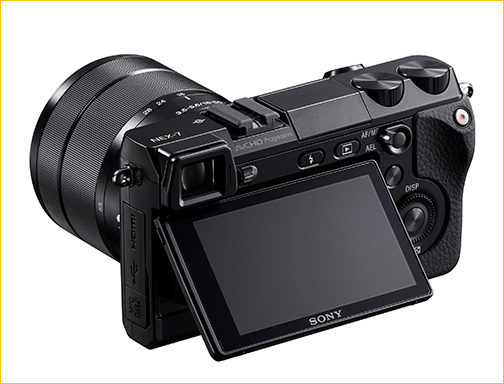
Never underestimate Sony.
They are the new kid on the block when it comes to mid-to-high-end digital photography, but they are an 800 pound guerrilla in the electronics industry, and the digital cameras industryis now the electronics industry.
When Sony purchasedKonica/Minoltain 2006 they acquired substantial SLR, DSLR, and optical lens technology along with staff and expertise. They also added a licensing / manufacturing relationship withCarl Zeiss, so that they could use that company’s lens technology for both digicams and DSLRs. Not to be discounted is the fact that Sony is one of the few camera makers that designs, engineers and fabricates their own sensors and other semiconductors. Indeed competitors such as Nikon and Pentax reportedly have Sony fabricate their sensors for them, sometimes based on Sony designs as well.
It’s now five years on, and Sony has had decent success with their Alpha cameras, and during the past 12 months with their NEX series of CSC (Compact Systems Cameras). Their A900 and A850 cameras have been the least expensive full-frame 24MP cameras on the market, and last year the A35 and A55 introduced Sony’s unique “Translucent Mirror” technology – a pelicle mirror that allows extremely high speed shooting, and continuous autofocus in video mode. The NEX cameras have offered up the smallest and lightest weight APS-C sensor cameras available, and have been very successful in some markets.
Now, in late August 2011, Sony has announced four new cameras, three of them with 24 Megapixel APS-C sensors, along with a new NEX model with a 16MP sensor, and a number of lenses and accessories. This isn’t just a large number of new products all at once – it’s a full-court-press on the rest of the industry. Let’s see what’s on tap.
Disclosure:I became very taken with Sony’s offerings when theA900came out several years ago, and I ended up buying one, along with the full range of Zeiss lenses, as well as some Sony G glass, their best branded lenses. I also have aNEX-5and set of E-mount lenses, because though I found the NEX poorly conceived from a user interface perspective, I found the combination of small size and light weight appealing, along with the fact that I could use all of my Zeiss and Sony A lenses using an adaptor, not to mention my Leica M lenses.
This means that I have a personal investment and bias toward Sony cameras, though as regular readers know I am not uncritical in areas where I fell Sony lets us down. Finally – of course all of this gear, just as with all products that I report on on these pages, was purchased at retail,as disclosed here.
Three New 24 Megapixel Cameras
If you’ve been reading the photo rumour sites during July and the first few weeks of August you know that the three new 24 Megapixel cameras are theSony A77,A65andNEX-7. I have no interest in publishing a laundry list of specs and features (the usual camera review sites do this very comprehensively), so rather I will focus on the things that strike me as being most interesting and important for photographers.
24 Megapixels on an APS-C sized sensor (1.5X factor) is a break-though. Most reduced frame sensors have been in the 12–18MP range till now, with 24MP reserved exclusively for full frame cameras from Nikon, Canon and Sony.
Of course image quality conscious photographers are going to ask – how will the higher pixel density of a 24MP APS-C sensor perform in terms of noise? The answer to this question will remain unknown for a few weeks, because at the time of this writing (mid-August) neither the hardware nor firmware is final.
Another issue (bound to be raised by the nattering classes on web forums) is whether 24MP is really needed, regardless of whether or not it entails any compromises in terms of IQ – which still remains to be seen.
Sidebar– Rather than leave this question hanging, let me address it head on. I believe that for many users 24MP may be overkill – though it will carry some cache for certain hobbyists. You will definitely want 24MP if…
-
-
You regularly makes prints larger than 13X19″
- You frequently do extensive cropping
- You use the best lenses available and use the best shooting techniques
-
If the above sounds like you, then you’ll likely be all over this new generation of cameras, and rightly so. But if you only make small prints, or just publish your work on-screen, or don’t use top glass and the best shooting technique, then it’s likely that all that a 24MP sensor equipped camera is going to give you is bragging rights.
So, with that bit of housekeeping out of the way, let’s look at what Sony hath wrought.
NB: The prices listed below were provided by Sony Canada, and are the MSRP for this country, in Canadian dollars. U.S. prices will be similar, or slightly lower. In other countries you’ll have to check with your local Sony web site or retailer.
Also my comments (subjective as always) are mostly based on just a couple of hours with these new cameras and accessories in an office setting. I reserve the right to change my mind once I get to do some field testing, which I expect to be able to do over the next few weeks.
Sony A77
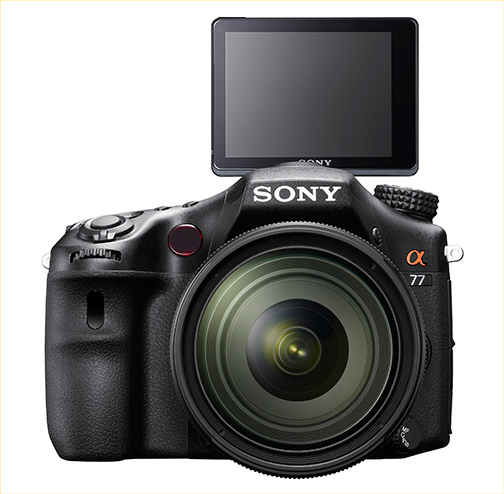
The new top-of-the-line camera from Sony is the A77.My pre-production hands-on impressions report is found here.
The basic specs are that the A77 has a 24.3 Megapixel APS-C sensor. It wll be priced at $1,495 body only, and sold together with the also new DF 16-50mm f/2.8 lens at $2,149. Availability will begin in early October. There will be a full-featured vertical grip available in October as well for $329.
The A77 is weather and dust sealed, as is the new 16-50mm f/2.8 lens. This is the first weather sealed lens from Sony, and the combo should appeal to photographers working in harsh conditions.
The A77 is capable of 12 FPS with continuous autofocus, one of the benefits of its translucent mirror technology. The viewfinder is electronic, using a brand new XGA resolution OLED with 2.3 Million pixels. This viewfinder is a stunner, offering significantly higher resolution, more saturated colours, and higher resolution than any EVF previously available. The viewfinder has eye detection, switching automatically between it and the rear LCD as needed.
Some users have complained about occasionally seeing “ghosting” in some extreme lighting situations due to the translucent mirror on the A35 and A33. Sony claims to have improved the mirror’s coating on these new models to help eliminate this issue.
The rear LCD is also a brand new articulated design, allowing positioning forward and above the camera, useful for when shooting stills and video with the photographer on-camera. The LCD’s mechanical mount seems particularly robust.
Other major specifications include 19 point autofocus with 11 Cross type sensors. Available ISO sensitivity ranges from 100 – 16,000 with an optional ISO 50 setting. The shutter mechanism is new, and is claimed to have a 150,000 actuation life, which is in pro-grade camera territory. The camera’s battery is the same as the one used in the A900/850 (horray) and the vertical grip, which can use two batteries, will drain the weaker one first before switching to the second, allowing the depleted battery to be changed first. Overall battery life is claimed to be very good as well, though again field testing will tell the tale.
As mentioned, the camera has a special 12FPS mode, but this locks out manual controls during the burst. When dropping down to just 8 FPS (just?!)full manual control of all settable parameters is possible. There is an electronic first curtain shutter, which is a feature previously seen on some Canon models. What is does is eliminate the need for a physical first shutter curtain. This means that there is absolutely no mechanical motion within the camera until after the exposure, when the second mechanical shutter curtain closes. This along with the fact that the A77 has continuous Live View, and no moving mirror because of its Translucent Mirror technology, means that the A77 will likely be one of the most vibration free cameras ever made. This will make it ideal for macro, microscope, long telephoto and telescope work.
Video has now become a must-have on all cameras, and Sony has pulled out all the stops this time. Nothing is held back. The A77 uses the new AVCHD 2.0 specification, which allows 1080P 50 or 60 FPS at higher data rates. Serious film makers will also rejoice, because the A77 features 24P, for natural motion picture style cadence. Full manual exposure controls are available when shooting video.
There is a built-in GPS and the camera’s top shutter speed is 1/8000 sec. There is a built-in flash along with Sony’s proprietary flash hot shoe, and the camera has a PC socket for studio use. As befits a top line camera there is AF fine tuning capability and lens aberration correction.
Wonder of wonders, Sony has brought back the large top LCD panel, highly useful for making settings and instantly being able to view the camera’s status and settings without the rear LCD or EVF. Thanks Sony! This is a major feature for photographers who do more than use their cameras as glorified point-and-shoots, and those who need to controls various settings on a real-time basis.
Speaking of control, the A77’s rear control button have been designed so that each one is at a slightly different height and has a differentfeel, so that settings by touch are enhanced – great for when working on low light conditions.
I don’t have the full skinny yet, but it appears that most control buttons can be customized to the user’s preference with up to 16 different functions being available for customization. So who needs video games?
I could go on, but at this point I’d just be spouting specs that you can now read on Sony’s web site. I expect to have an A77 for field testing very soon and will have an in-depth hands-on preview here as soon as I do.
One final thought for now. The A77 is a “pretty” camera; one of the nicest styled cameras in a long time. It has a very organic shape and falls to hand very nciely as well. Only a field test though will tell is beauty is skin deep or not.
I had an opportunity to spend four days in early August working with a pre-production A77.
That Reporttherefore does not examine any aspect of the product that might change prior to release.
That means that I did not comment on feature operation or image quality, both of which are subject to change prior to first shipment.
Sony A65
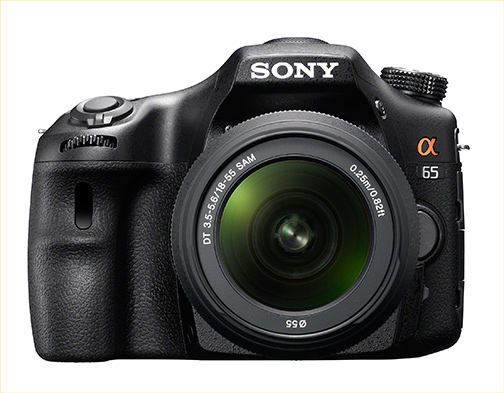
The new A65 slots in below the A77 and above the A55, which remains in the line for now. Like the A77 it has the same 24.3MP sensor, 2.3MP OLED electronic viewfinder, Translucent Mirror technology, and is capable of data rates up to 10 FPS. The body will be priced at $1,049, or $1,149 with the 18-55mm kit lens. Availability is early October.
The A65 is quite a bit smaller and lighter than the A77 but has most of the important features mentioned, including full AVCHD video capability with 24 FPS and full manual controls, built-in GPS, mic input for video, and a maximum ISO of 16,000.
When you see the A77 and the A65 side-by-side you realize that the A65 is from the same “family” as the A55, while the A77 is pushing upmarket into a segment that Sony hasn’t played in before.
There is a 15 point AF system with 3 cross type sensors as well as object tracking autofocus. There is a “Smart Teleconverter” mode which really is just in-camera cropping. If you are the type of person that doesn’t work on your images in the computer, this may be useful, but is nothing that one can’t do on the computer with cropping.
I didn’t mention it in the A77 report, but because of the much higher screen resolution of the OLED electronic viewfinder both it and the A65 allow for important shooting data to be displayed above and below the image, as with a high-end an optical viewfinder, thus allowing an unobstructed view of the subject.
The A65 is quite a bit smaller than the A77, though is has a “family” style. At some $500 less than the A77 it offers quite a high spec capability without much in the way of compromise for many photographers. For example, just two of the camera controls are customizable, AEL on the rear and ISO on the top panel. Since the image quality on the A65 will be the same as on the A77, and the new EVF is the same, it seems that if ultra-high frame rates and weather proofing aren’t that important to you, and smaller size and saving money is, the A65 may turn out to be a very attractive alternative.
I’ll just make the observation here that what Sony appears to be doing with their camera line is creating product segmentation by feature, not by capability. In other words the A65 still have the same EVF, sensor and video capability as the A77. This is refreshing, because so many other companies seem to artificially remove capabilities from lower end models just so that they can carve out a different market segment. Nicely done Sony.
NEX-7
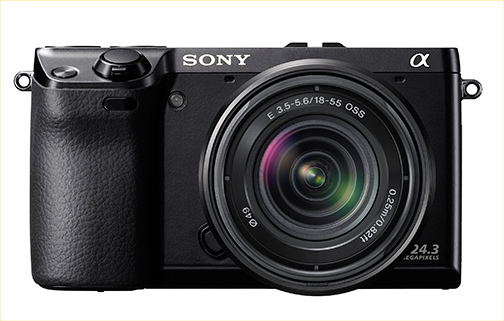
The NEX-7 is a serious game changer. In a body not much bigger than the original NEX-5 Sony has put both its new 24.3 Megapixel APS-C sensor and 2.3MP OLED electronic viewfinder, but also some very welcome new manual controls. The camera’s cosmetic design also has a sleekness and minimalism that will appeal to many.
I was particularly taken with the fact that Sony didn’t feel that they had to add an SLR style “prism bump” when they added an EVF to the NEX. It always seemed so redundant to me to have this unnecessary appendage on cameras that don’t actually have prisms, and it consequently helps make the NEX-7 much smaller and more svelte in appearance.
The list of new features is impressive, and includes an electronic level gauge visible in the EVF, as well as on the LCD, eye detection capability for viewfinder switching, and AVCHD 2.0. the same as on the A77, with 60P and 24P capability.
Like the A77, top ISO is 16,000. Remarkably, given the camera’s diminutive size, there is a pop-up flashanda standard Sony hot shoe built in.
One of the most interesting aspects of the NEX-7 are the two Tri-Nav “soft” wheels that are built into the top panel. They can be programmed to take on a variety of different functions, depending on how the user has programmed them. There is also a new Navigation button near the shutter release that can be customized with a number of different capabilitis, including Focus, White Balance, D-Range, Creative and Picture Effects.
On the whole, though it still retains Sony’s less than admirable NEX menu interface, the camera seems much more customizable than many of us had dared to hope.
The camera body will retail for $1,199, or $1,399 with the kit 18-55mm lens, and will start shipping in late October. This lens will come in black finish to match the camera, but only when purchased as part of the kit with body.
The so-calledCompact System Camerasegment is hot right now, and with the new NEX-7 Sony has staked out the high ground. Of course the NEX-7’s main competitor is thePanasonic GH2, a camera which I am very fond of. The Sony NEX-7 challenges it by offering a larger sensor (APS-C vs. MFT), higher resolution (24MP vs. 16MP), a higher resolution EVF, and equally full-featured HD video, but at a higher data rate. Oh yes, and it’s also somewhat lighter weight and smaller.
NEX-5N
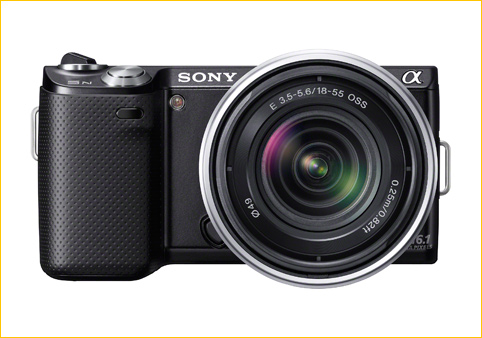
The NEX-5N replaces the original NEX-5. It has similar cosmetics and is even a bit narrower. The sensor is now 16 Megapixels, and shutter lag has been lowered considerably according to Sony. Like its new siblings the 5N has full 1920X1080 HD video at 24P or 60P using AVCHD 2.0. The camera has the ability to shoot video in all modes and has manual setting capabilities for video shooting.
ISO range on the 5N is up to 25,500 (!) and the camera can shoot at the rate of 10 FPS. Sony is claiming that focus speed is now as fast as the Panasonic GH2 and that shutter lag is even lower than before; just 20Ms, vs. 100Ms for the original NEX-5. There is subject tracking and also face recognition.
Sony is claiming superior battery life from the same battery as used in the NEX-5; 430 shots vs. 330. The 5N now also has an ultrasonic vibration dust removal system rather than just an electrostatic system.
The 5N has a hybrid touch-screen. Not all features are “touchable”, but things like focus point selection and image browsing are.
The NEX-5N also is now able to accept an accessory electronic viewfinder via its Intelligent Accessory mount. It’s called the FDA-EV1 and features the same excellent 2.4MP OLED screen as the other cameras mentioned here. It is articulated, so that it tilts upward, and will cost $399 when it becomes available in early September. The NEX-5N will become available in early September as well, and will ship with the 18-55mm kit lens for $799. It will not be available as ‘body only’.
The new EVF is regrettably not compatible with previous NEX models as the required pin-outs don’t exist on those bodies.
Accessories
LA-EA2
There is a new lens adaptor called the LA-EA2 that allows for mounting all Sony Alpha lenses on NEX cameras. It’s advantage over the previous EA1 is that it has a Translucent Mirror incorporated, and this allow for phase detection autofocus, which means that all Sony lenses, not just SSM and SAM models can be used with full fast AF.
The LA-EA2 will become available in late September at a price of $449. The lens adaptor will be usable with previous NEX models, as well as the VG-10 camcorder, with an appropriate user-installed firmware upgrade.
NEX E-Mount Lenses
There are three new NEX lenses coming.
Zeiss 24mm f/1.8
This is the first Zeiss lens from Sony in NEX mount, though almost certainly not the last. It will be priced at $1,099 and will be available in early December.
Sony 50mm f/1.8 OSS
This lens is optically stabilized and at about 75mm equivalence will be an ideal portrait lens. It will cost $349.
Sony 55–210mm f/4.5 – f/6.3 OSS
This medium telephoto zoom is optically stabilized and will be available beginning in early October at $399.
Alpha Mount Lens
Sony DT 16-50mm f/2.8 SSM
This new medium focal length zoom is equivalent to a 24-70mm in full frame terms. It is a DT lens, which means that it’s designed specifically for cropped frame sensors like that in the A77.
This is a a very popular focal range and aperture combination on just about every format camera. This new lens will become available in early October for $799, and is the first Sony lens to be weather sealed. At this price point one would think that it would be a Zeiss, or at least have a Sony G series designation, but it is neither. The lens appears to be beautifully built though, and I can’t wait to get may hands on one for testing.
Sony VG20 Video Camera
Utilizing the same lens E-Mount as the NEX still cameras, the successor to last year’s VG-10 is the VG-20. Its sensor has been upped from 14.2 to 16.1 Megapixels and it can shoot raw in stills mode. It is the same new sensor as found in the NEX-5N.
Audio has been improved to Dolby 5.1 and there have been some control and interface improvements as well as new audio gain controls and a newly designed grip. There is now an assignable control dial, and like all new Sony cameras the codec ante has been upped to AVCHD 2.0 with 60P and 24P.
The VG20 will become available in early November, and the body only will cost $1,599.
Whew!
That’s Sony’s new product lineup for Q4, 2011, and quite an aggressive product line-up it is. With so many new products coming in such a short period reviewers are going to be kept busy for the next few months, and the discussion forums are bound to be full of chatter, both pro and con the various products.
I am looking forward to testing and working in the field with as much of this gear as possible, and will have reports available here as soon as I do.
As a parting comment though, prospective purchasers of any of these new 24MP cameras, the A77, A65 and NEX-7, should consider which one might best suit their needs. They all have the same 24.3 Megapixel sensor and the same 2.3MP OLED electronic viewfinder, and same high-end AVCHD 2.0 video capability. The A77 is large, heavy, has the highest frame rates, and a GPS. The A65 is smaller, lighter and less expensive, though without weather sealing. The NEX-7 is smaller still, takes smaller E-mount lenses, but with the new LA-EA2 Translucent Mirror A-Mount adaptor can take any Sony Alpha mount lens and use it with fast Phase Detection AF. Oh yes, and the NEX-7 can also take Leica M lenses, and indeed just about any other lens you care to throw at it. One downside of the NEX-7 when used with Alpha lenses is that there is no in-body stabilization, since longer E-Mount lenses have OSS built-in.
Quite a range of choices, and one that no other camera maker can currently offer. It will be very interesting to see how both Canon and Nikon respond to Sony’s aggresive new offerings.
24 August, 2011
You May Also Enjoy...
Fall Up The Mountian
FacebookTweet In August, The Luminous Landscape and my family picked up and moved to Montreal Quebec Canada. Montreal is a rare city that remains full
Shooting With The Masters – Charles Cramer Part 1
FacebookTweet A Fun Adventure In Northern California With Charles Cramer Last year Luminous Landscape presented its first Shooting With The Masters video series. The first

